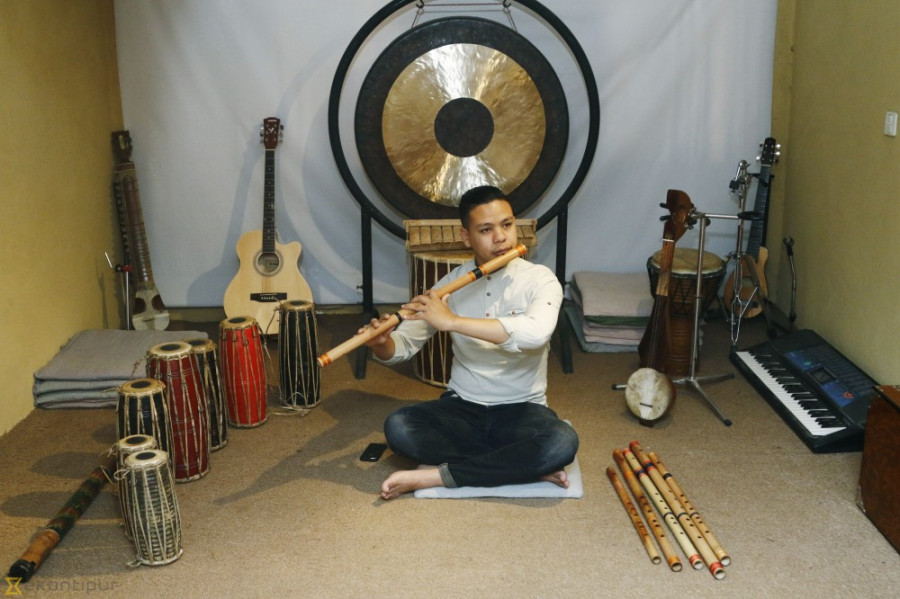Entertainment
This young man’s flute covers have millions of views. Here’s why he chose to cover Despacito.
Swarnim Maharjan is fusing popular tracks with traditional sounds to keep young people listening to Nepali music.
Sneha Dahal
From the very first strains of the guitar, you know what song this is. As the guitar fades into the background, the flute picks up a familiar melody. Though there are no vocals in the video, the flute rings through each guitar chord, outshining its metallic twang.
Swarnim Maharjan’s flute cover of the song ‘Despacito’ is a unique take on a song known primarily for its ubiquity. And at 6.3 million views, it is among Maharjan’s most popular videos, critical in earning the 20-year-old flautist a silver plaque from YouTube for crossing 100,000 subscribers on his channel.
As views skyrocketed, Maharjan received a lot of praise from all around the world. Some said that his version was better than the original while others expressed a sense of pride at seeing Maharjan, a Nepali, holding a flute and not a guitar.
But Maharjan wasn’t always so adept at playing the flute. It was his father, Raman Maharjan, who was the master flautist.
“I grew up with the sound of my father’s flute ringing in my ears,” said Maharjan. “I tried to play it too but six-year-old me couldn’t. My fingers were too short.”
A year later, at the age of seven, Maharjan’s fingers could finally find the holes on the flute, and he began playing regularly, inspired by his father.
After finishing his grade 10, Maharjan joined Sirjana College of Fine Arts and studied vocals for two years, learning about various traditional Nepali instruments and their history.
“The people I met would usually start a conversation by asking me what I was studying,” said Maharjan. “My reply that I was studying music would get a confused reaction from them, inducing questions like that’s fine but what else do you study?”
In Nepal, people aren’t willing to accept traditional music as a career choice, said Maharjan, as one cannot earn much money in this field unless they are lucky enough to get recognised. Music isn’t considered a ‘safe option’ like engineering, IT or science. But that never stopped Maharjan, who is currently doing his undergraduate in Fine Arts from Tribhuvan University.
Despite pursuing music professionally, Maharjan feels that many still see his music more as a hobby than a legitimate career option. But he seems to believe that the love for music endures, no matter how much you might try to kill it.
“I once met a man who told me that he had joined the British army even though he wanted to pursue music because his family pressured him to do so. Today he is married, has kids and is retired. He has now decided to dive back into music again,” Maharjan said.
Maharjan's passion for music comes largely from his father. Their home is even named ‘Music House’, a project started by his father to pursue music and bring traditional Nepali instruments back into the popular mainstream.
According to Maharjan, many students studying music at Tribhuvan University and other colleges come to Music House for practical lessons. The fact that students have to go to places outside their institutions in order to practice instruments says a lot about the quality of practical teaching that happens in Nepal, said Maharjan.
Maharjan attempts to do what he can to bring traditional Nepali instruments back into the mainstream, like he did with Despacito and a number of other covers of popular songs, including one of the theme song from Titanic that has over 5 million views.
He also does the same with his band, Manda, where he naturally plays the flute. He started the band when he was still in school and they’ve been playing together for more than 10 years.
In 2012, when he was just 12, Manda won first place at the Celesta Orchestra Competition, organised by City Montessori School in Aliganj, Lucknow, for their original composition titled ‘Shasan Kaal’. Maharjan was named best performer.
“The word ‘manda’ comes from the Newari word ‘mandala’. Just as a mandala is an amalgamation of different colours, patterns and designs, our band represents a variety of musical cultures through Nepali and western musical instruments,” said Maharjan.
Released in 2016, Manda band’s first album Naya Soch sold over 20,000 copies, said Maharjan. The album is a collection of local Nepali melodies representing the Himalayan, Hilly and Tarai regions of the country. The idea was to inspire the youth of the nation by letting them feel the power of traditional instruments like the flute, madal, dhimey, khin, sarangi, and tungna.
“The sound your flute produces is directly linked to your emotional state. If you’re happy, the melody is going to sound jolly and if you’re sad then it will generate sadness. That’s the power of a flute, the art is transparent unlike music produced by electronic devices where emotions aren’t refelected as much,” said Maharjan.
With a decade of training and practicing the flute, Maharjan believes that western music allows the free-form use of instruments where the act of customisation is seen as ‘art’, whereas classical music has strict structures and rules to follow, which can put off Nepali youth. This is why Maharjan is attempting to fuse eastern and western music through his covers and his band. He aims to capture the attention of young people by gradually building a Nepali essence into his band’s creations, bringing in indigenous melodies.
“There’s no way that a kid listening to Justin Bieber, Charlie Puth and Young Thug will instantly start liking music produced by a flute or a tabla or panche baaja,” said Maharjan. “But if families and schools introduce children to traditional Nepali instruments, educate them about their history and encourage them to pursue it as a career, then these instruments can take us a long way in the field of music.”




 17.67°C Kathmandu
17.67°C Kathmandu










